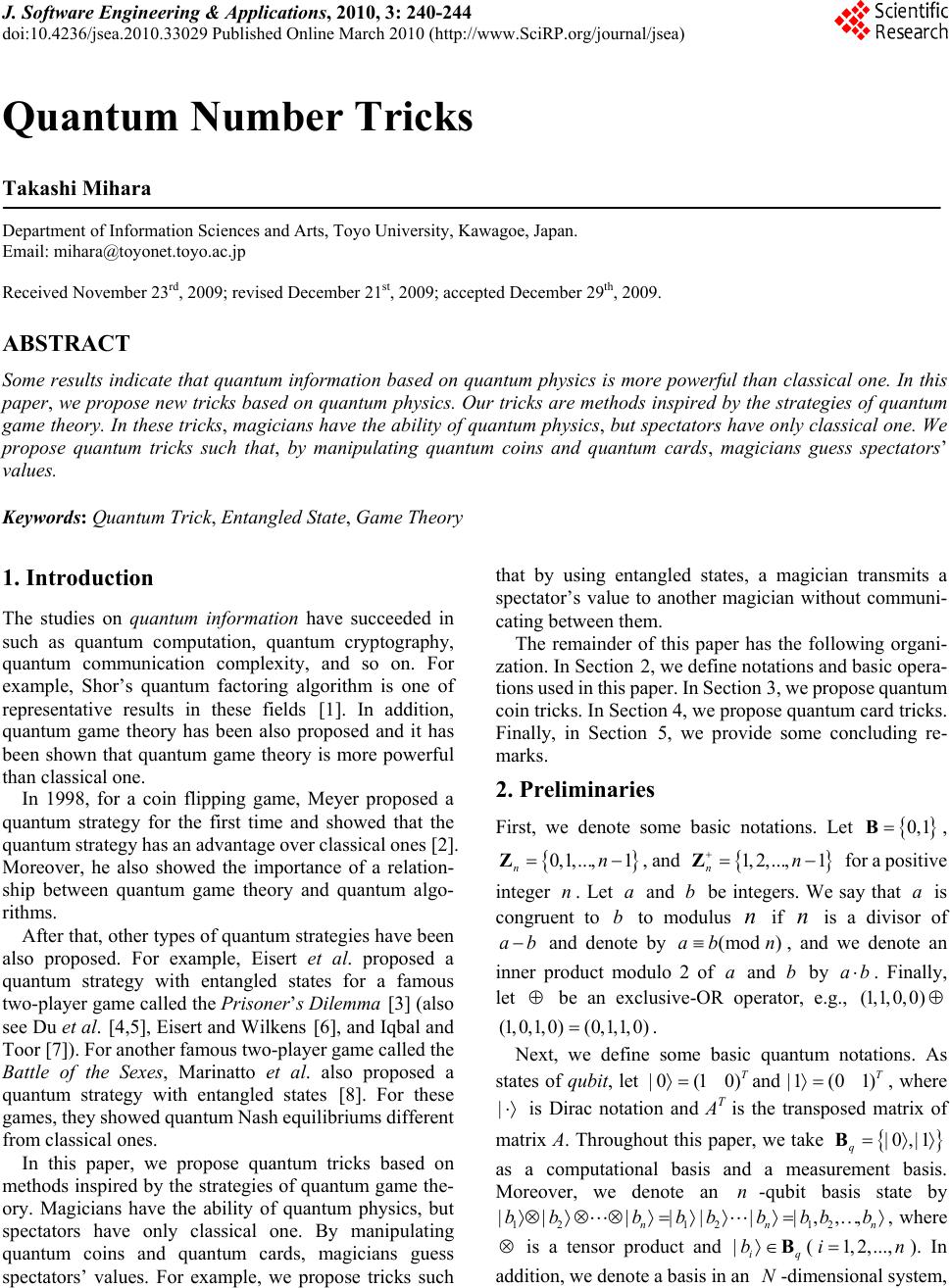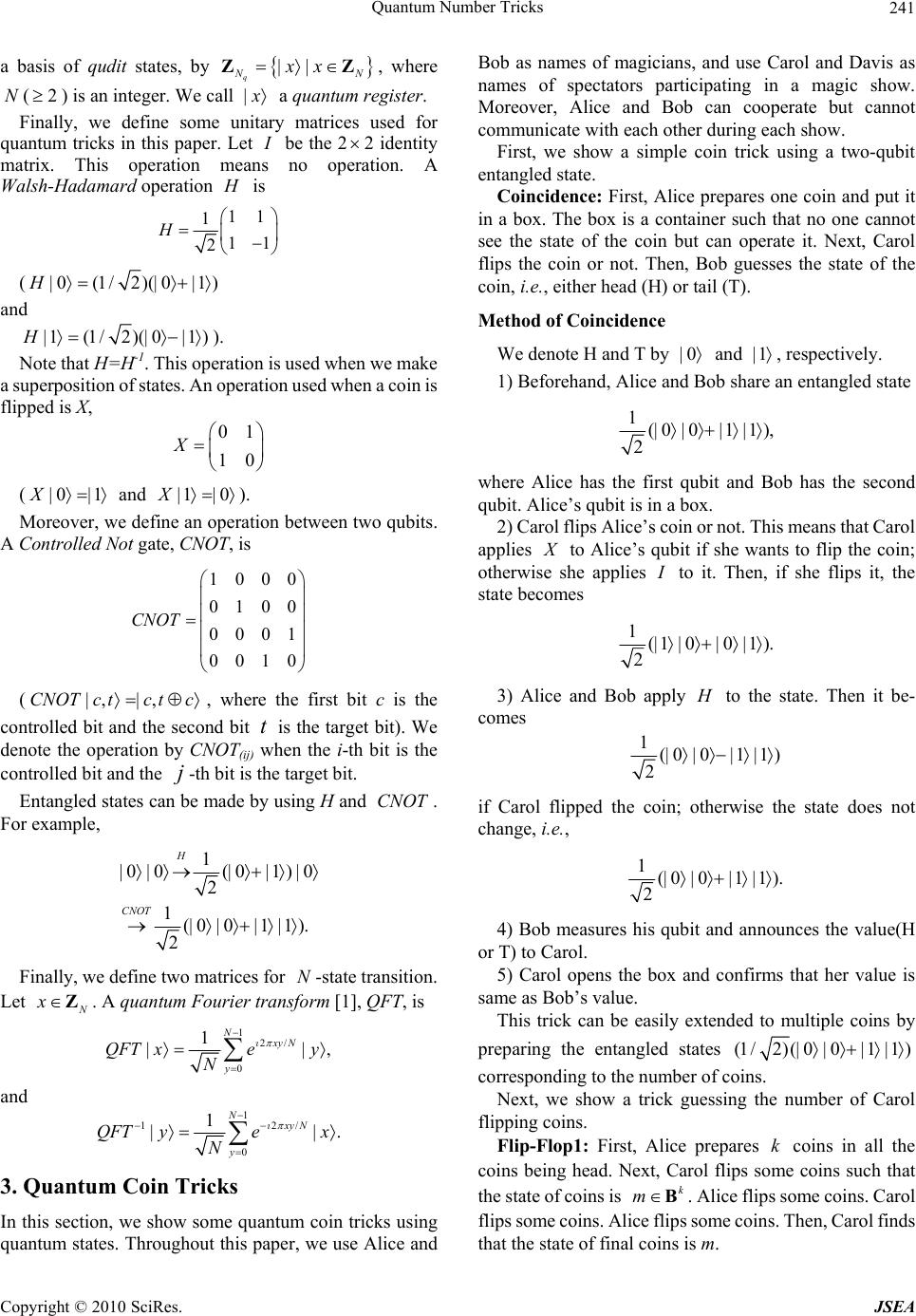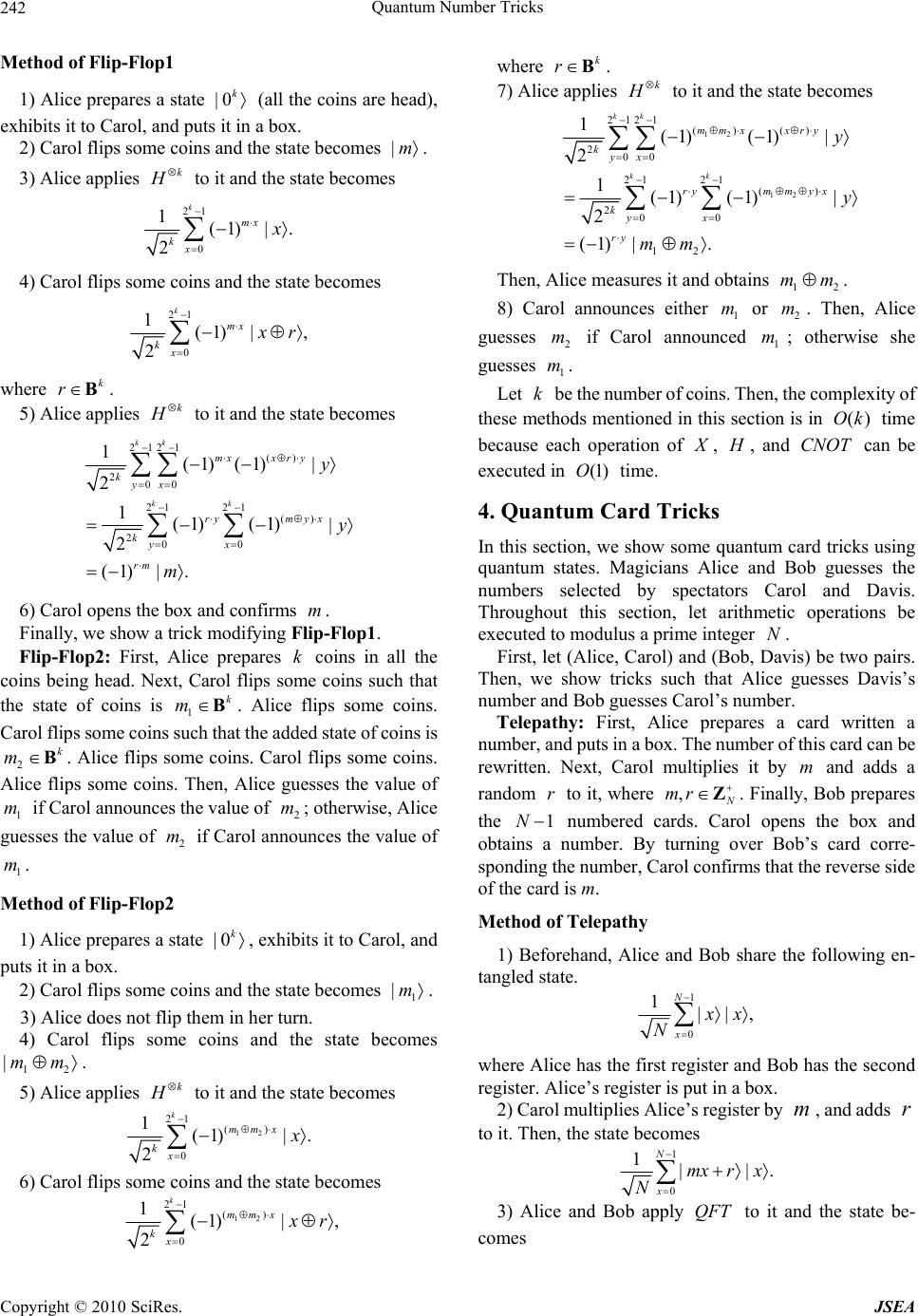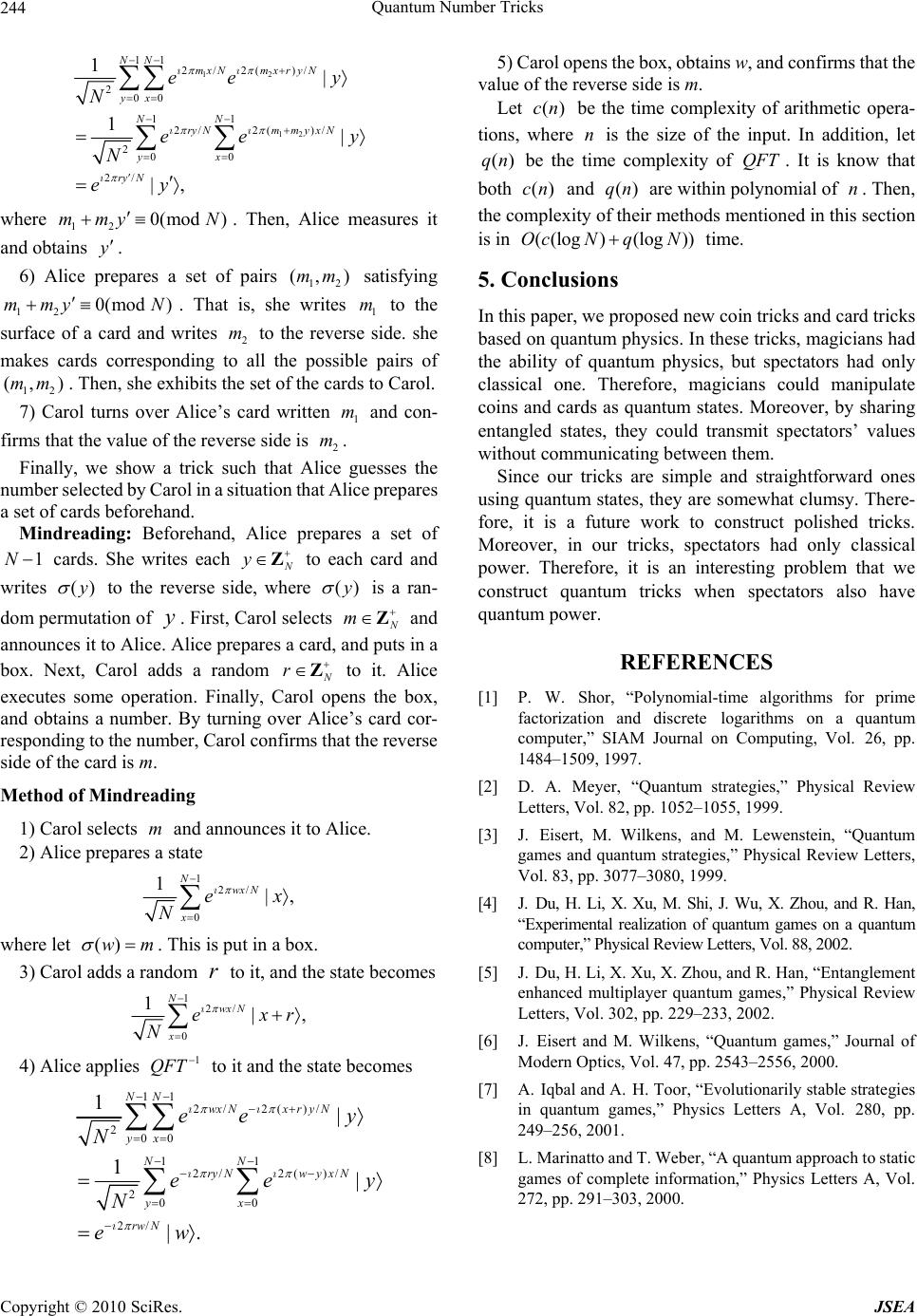Paper Menu >>
Journal Menu >>
 J. Software Engineering & Applications, 2010, 3: 240-244 doi:10.4236/jsea.2010.33029 Published Online March 2010 (http://www.SciRP.org/journal/jsea) Quantum Number Tricks Takashi Mihara Department of Information Sciences and Arts, Toyo University, Kawagoe, Japan. Email: mihara@toyonet.toyo.ac.jp Received November 23rd, 2009; revised December 21st, 2009; accepted December 29th, 2009. ABSTRACT Some results indicate that quantum information based on quantum physics is more powerful than classical one. In this paper, we propose new tricks based on quantum physics. Our tricks are methods inspired by the strategies of quantum game theory. In these tricks, magicians have the ability of quantum physics, but spectators have only classical one. We propose quantum tricks such that, by manipulating quantum coins and quantum cards, magicians guess spectators’ values. Keywords: Quantum Trick, Entangled State, Game Theory 1. Introduction The studies on quantum information have succeeded in such as quantum computation, quantum cryptography, quantum communication complexity, and so on. For example, Shor’s quantum factoring algorithm is one of representative results in these fields [1]. In addition, quantum game theory has been also proposed and it has been shown that quantum game theory is more powerful than classical one. In 1998, for a coin flipping game, Meyer proposed a quantum strategy for the first time and showed that the quantum strategy has an advantage over classical ones [2]. Moreover, he also showed the importance of a relation- ship between quantum game theory and quantum algo- rithms. After that, other types of quantum strategies have been also proposed. For example, Eisert et al. proposed a quantum strategy with entangled states for a famous two-player game called the Prisoner’s Dilemma [3] (also see Du et al. [4,5], Eisert and Wilkens [6], and Iqbal and Toor [7]). For another famous two-player game called the Battle of the Sexes, Marinatto et al. also proposed a quantum strategy with entangled states [8]. For these games, they showed quantum Nash equilibriums different from classical ones. In this paper, we propose quantum tricks based on methods inspired by the strategies of quantum game the- ory. Magicians have the ability of quantum physics, but spectators have only classical one. By manipulating quantum coins and quantum cards, magicians guess spectators’ values. For example, we propose tricks such that by using entangled states, a magician transmits a spectator’s value to another magician without communi- cating between them. The remainder of this paper has the following organi- zation. In Section 2, we define notations and basic opera- tions used in this paper. In Section 3, we propose quantum coin tricks. In Section 4, we propose quantum card tricks. Finally, in Section 5, we provide some concluding re- marks. 2. Preliminaries First, we denote some basic notations. Let 01 B, 0 1 ...1 nn Z n a b ab , and for a positive integer . Let and be integers. We say that is congruent to to modulus if is a divisor of 1 2 ...1 nn Z b n n a and denote by (mod )ab n , and we denote an inner product modulo 2 of and b by . Finally, let aab be an exclusive-OR operator, e.g., (1 100) (1 0 1 0)(011 0) . Next, we define some basic quantum notations. As states of qubit, let and , where 0(10) T 1(01) T is Dirac notation and AT is the transposed matrix of matrix A. Throughout this paper, we take 01 q n B 12 …bbb as a computational basis and a measurement basis. Moreover, we denote an -qubit basis state by n 12 bbb 12 nn bb b , where is a tensor product and iq b N B1, 2,...,(). In addition, we denote a basis in an -dimensional system, in  Quantum Number Tricks241 a basis of qudit states, by , where () is an integer. We call q NN xxZZ N2 x a quantum register. Finally, we define some unitary matrices used for quantum tricks in this paper. Let I be the 22 identity matrix. This operation means no operation. A Walsh-Hadamard operation H is 11 1 11 2 H (0(12)(01)H and 1(12)(01)H ). Note that H=H-1. This operation is used when we make a superposition of states. An operation used when a coin is flipped is X, 01 10 X ( and ). 01X 10X Moreover, we define an operation between two qubits. A Controlled Not gate, CNOT, is 1000 0100 0001 0010 CNOT (, where the first bit c is the controlled bit and the second bit is the target bit). We denote the operation by CNOT(ij) when the i-th bit is the controlled bit and the CNOTctc tc t j -th bit is the target bit. Entangled states can be made by using H and . For example, CNOT 1 00(01)0 2 1(001 1) 2 N H COT Finally, we define two matrices for -state transition. Let . A quantum Fourier transform [1], QFT, is N N xZ 1 2 0 1 | N xy N y QFT xey N and 1 12 0 1N xy N y QFT yex N 3. Quantum Coin Tricks In this section, we show some quantum coin tricks using quantum states. Throughout this paper, we use Alice and Bob as names of magicians, and use Carol and Davis as names of spectators participating in a magic show. Moreover, Alice and Bob can cooperate but cannot communicate with each other during each show. First, we show a simple coin trick using a two-qubit entangled state. Coincidence: First, Alice prepares one coin and put it in a box. The box is a container such that no one cannot see the state of the coin but can operate it. Next, Carol flips the coin or not. Then, Bob guesses the state of the coin, i.e., either head (H) or tail (T). Method of Coincidence We denote H and T by 0 and , respectively. 1 1) Beforehand, Alice and Bob share an entangled state 1(001 1) 2 where Alice has the first qubit and Bob has the second qubit. Alice’s qubit is in a box. 2) Carol flips Alice’s coin or not. This means that Carol applies X to Alice’s qubit if she wants to flip the coin; otherwise she applies I to it. Then, if she flips it, the state becomes 1(1 00 1) 2 3) Alice and Bob apply H to the state. Then it be- comes 1(0011) 2 if Carol flipped the coin; otherwise the state does not change, i.e., 1(001 1) 2 4) Bob measures his qubit and announces the value(H or T) to Carol. 5) Carol opens the box and confirms that her value is same as Bob’s value. This trick can be easily extended to multiple coins by preparing the entangled states (12) (0011) corresponding to the number of coins. Next, we show a trick guessing the number of Carol flipping coins. Flip-Flop1: First, Alice prepares coins in all the coins being head. Next, Carol flips some coins such that the state of coins is . Alice flips some coins. Carol flips some coins. Alice flips some coins. Then, Carol finds that the state of final coins is m. k k mB Copyright © 2010 SciRes. JSEA  Quantum Number Tricks 242 Method of Flip-Flop1 1) Alice prepares a state (all the coins are head), exhibits it to Carol, and puts it in a box. 0k 2) Carol flips some coins and the state becomes m . 3) Alice applies k H to it and the state becomes 21 0 1(1) 2 k mx kx x 4) Carol flips some coins and the state becomes 21 0 1(1) 2 k mx kx x r where . k rB 5) Alice applies k H to it and the state becomes 2121 () 200 21 21 () 200 1(1) (1) 2 1(1) (1) 2 (1) kk kk mxx r y kyx rymy x kyx rm y y m 6) Carol opens the box and confirms . m Finally, we show a trick modifying Flip-Flop1. Flip-Flop2: First, Alice prepares k coins in all the coins being head. Next, Carol flips some coins such that the state of coins is . Alice flips some coins. Carol flips some coins such that the added state of coins is . Alice flips some coins. Carol flips some coins. Alice flips some coins. Then, Alice guesses the value of if Carol announces the value of ; otherwise, Alice guesses the value of if Carol announces the value of . 1 k mB 2 m 2 k mB 1 m 1 m 2 m Method of Flip-Flop2 1) Alice prepares a state 0k , exhibits it to Carol, and puts it in a box. 2) Carol flips some coins and the state becomes 1 m . 3) Alice does not flip them in her turn. 4) Carol flips some coins and the state becomes . 12 mm 5) Alice applies k H to it and the state becomes 12 21 () 0 1(1) 2 k mmx kx x 6) Carol flips some coins and the state becomes 12 21 () 0 1(1) 2 k mmx kx x r where k r B. 7) Alice applies k H to it and the state becomes 12 12 2121 () () 200 21 21 () 200 12 1(1) (1) 2 1(1) (1) 2 (1) kk kk mmx xry kyx mm yx ry kyx ry y y mm Then, Alice measures it and obtains . 12 mm 8) Carol announces either or . Then, Alice guesses if Carol announced ; otherwise she guesses . 1 m2 m 12 m 1 m m Let be the number of coins. Then, the complexity of these methods mentioned in this section is in time because each operation of k ()Ok X , H , and can be executed in time. CNOT (1)O 4. Quantum Card Tricks In this section, we show some quantum card tricks using quantum states. Magicians Alice and Bob guesses the numbers selected by spectators Carol and Davis. Throughout this section, let arithmetic operations be executed to modulus a prime integer . N First, let (Alice, Carol) and (Bob, Davis) be two pairs. Then, we show tricks such that Alice guesses Davis’s number and Bob guesses Carol’s number. Telepathy: First, Alice prepares a card written a number, and puts in a box. The number of this card can be rewritten. Next, Carol multiplies it by and adds a random to it, where . Finally, Bob prepares the m r 1 N mr Z N numbered cards. Carol opens the box and obtains a number. By turning over Bob’s card corre- sponding the number, Carol confirms that the reverse side of the card is m. Method of Telepathy 1) Beforehand, Alice and Bob share the following en- tangled state. 1 0 1N x x x N where Alice has the first register and Bob has the second register. Alice’s register is put in a box. 2) Carol multiplies Alice’s register by , and adds to it. Then, the state becomes mr 1 0 1N x mx rx N 3) Alice and Bob apply to it and the state be- comes QFT Copyright © 2010 SciRes. JSEA  Quantum Number Tricks243 12 12 112 12 1 12 111 2( )2 12 3000 111 22() 12 3000 2 12 0(mod ) 1 1 1 NNN mxr yNxyN yy x NNN ryNmyyxN yyx ry N my yN eeyy N eey N eyy N y ) Then, Bob measures it and obtains satisfying . 2 y 12 0(mod )my yN 4) Bob prepares a set of pairs satisfying . That is, he writes to the sur- face of a card and writes to the reverse side. He makes cards corresponding to all the possible pairs of . Then, he exhibits the set of the cards to Carol. 1 (my 1 y 12 0(mod )my yN 1 ()my m 5) Carol opens the box and knows . Then, she turns over Bob’s card written and confirms that the value of the reverse side is m. 1 y 1 y Mutual Telepathy: Let Alice and Carol be one pair, and Bob and Davis be another pair. First, Alice prepares a card written a number, and puts in a box. Bob also pre- pares a card written a number, and puts in another box. Next, Carol multiplies it by , and adds a random to it. Davis multiplies it by , and adds a random to it. Here, . Finally, Bob prepares the 1 m 2 1 r N m2 r 1212 N mmrr Z1 numbered cards. Carol opens the box and obtains a number. By turning over Bob’s card corresponding the number, Carol confirms that the reverse side of the card is . In addition, Alice prepares the numbered cards. Davis opens the box and obtains a number. By turning over Alice’s card corresponding the number, Davis confirms that the reverse side of the card is . 1 m1N 2 m Method of Mutual Telepathy 1) Beforehand, Alice and Bob share the following en- tangled state. 1 0 1N x x x N where Alice has the first register and Bob has the second register. Alice’s register is put in a box, and Bob’s register is put another box. 2) Carol multiplies Alice’s register by and adds to it. Davis multiplies Bob’s register by and adds to it. Then, the state becomes 1 m 2 m 1 r 2 r 1 1122 0 1N x mx rmx r N In addition, Davis announces to Bob. 2 m 3) Alice and Bob apply to it and the state be- comes QFT 1122112 2 12 1122 112 2 11 1 2( )2() 12 300 0 2( ) 12 0(mod ) 1 1 NN N ry ryNmy myxN yy x ry ryN mym yN ee y N eyy N y Then, Alice and Bob measure it and obtain 1 y and 2 y , respectively, satisfying . 112 20(momym yd )N 4) Bob prepares a set of pairs satisfying 11 (my) 112 20(mod )mym yN 11 ()my . That is, he writes to the surface of a card and writes to the reverse side. He makes cards corresponding to all the possible pairs of 1 y 1 m . Then, he exhibits the set of the cards to Carol. 5) Carol opens the box and knows y1. Then, she turns over Bob’s card written y1 and confirms that the value of the reverse side is m1. Note that Alice can also know m1 here. 6) Alice also prepares a set of pairs (m2,y2) satisfying 112 20(mod )mym yN , and Davis can find the correct pair (m2,y2). Next, we show a card trick similar to Flip-Flop2. Prediction: First, Alice prepares a card written 0, and puts it in a box. Next, Carol adds to it. Alice executes some operation. Carol multiplies it by m2 and adds a random to it, where . Alice executes some operation, opens the box, and obtains a number. Finally, Alice prepares the N–1 numbered cards. By turn- ing over Alice’s card corresponding m1, Carol confirms that the reverse side of the card is m2. 1N m Z N Zr2 mr Method of Prediction 1) Alice prepares a state , exhibits it to Carol, and puts it in a box. 0 2) Carol adds to it and the state becomes 1 m1 m . 3) Alice applies to it and the state becomes QFT 1 1 2 0 1N mxN x ex N 4) Carol multiplies it by and adds to it. Then, the state becomes 2 m r 1 1 2 2 0 1N mx N x emx N r 5) Alice applies to it and the state becomes QFT Copyright © 2010 SciRes. JSEA  Quantum Number Tricks Copyright © 2010 SciRes. JSEA 244 5) Carol opens the box, obtains w, and confirms that the value of the reverse side is m. 12 12 11 22() 200 11 2( ) 2 200 2 1 1 NN mxNm xryN yx NN mmyxN ry N yx ry N ee y N ee N ey y Let be the time complexity of arithmetic opera- tions, where is the size of the input. In addition, let be the time complexity of QF . It is know that both and are within polynomial of . Then, the complexity of their methods mentioned in this section is in ()cn ()cn ((loOc n gN ()qn T ()qn ) (lq n og ))N time. where . Then, Alice measures it and obtains . 12 0(mod )mmyN y 6) Alice prepares a set of pairs satisfying . That is, she writes to the surface of a card and writes to the reverse side. she makes cards corresponding to all the possible pairs of . Then, she exhibits the set of the cards to Carol. 12 (mm) 12 0(mod )mmyN 12 ()mm 1 m 2 m 5. Conclusions In this paper, we proposed new coin tricks and card tricks based on quantum physics. In these tricks, magicians had the ability of quantum physics, but spectators had only classical one. Therefore, magicians could manipulate coins and cards as quantum states. Moreover, by sharing entangled states, they could transmit spectators’ values without communicating between them. 7) Carol turns over Alice’s card written and con- firms that the value of the reverse side is . 1 m 2 m Finally, we show a trick such that Alice guesses the number selected by Carol in a situation that Alice prepares a set of cards beforehand. Since our tricks are simple and straightforward ones using quantum states, they are somewhat clumsy. There- fore, it is a future work to construct polished tricks. Moreover, in our tricks, spectators had only classical power. Therefore, it is an interesting problem that we construct quantum tricks when spectators also have quantum power. Mindreading: Beforehand, Alice prepares a set of cards. She writes each to each card and writes 1NN y Z ()y to the reverse side, where ()y is a ran- dom permutation of y . First, Carol selects N m N Z Z and announces it to Alice. Alice prepares a card, and puts in a box. Next, Carol adds a random to it. Alice executes some operation. Finally, Carol opens the box, and obtains a number. By turning over Alice’s card cor- responding to the number, Carol confirms that the reverse side of the card is m. rREFERENCES [1] P. W. Shor, “Polynomial-time algorithms for prime factorization and discrete logarithms on a quantum computer,” SIAM Journal on Computing, Vol. 26, pp. 1484–1509, 1997. [2] D. A. Meyer, “Quantum strategies,” Physical Review Letters, Vol. 82, pp. 1052–1055, 1999. Method of Mindreading 1) Carol selects and announces it to Alice. m[3] J. Eisert, M. Wilkens, and M. Lewenstein, “Quantum games and quantum strategies,” Physical Review Letters, Vol. 83, pp. 3077–3080, 1999. 2) Alice prepares a state 1 2 0 1N wxN x ex N [4] J. Du, H. Li, X. Xu, M. Shi, J. Wu, X. Zhou, and R. Han, “Experimental realization of quantum games on a quantum computer,” Physical Review Letters, Vol. 88, 2002. where let ()wm . This is put in a box. 3) Carol adds a random to it, and the state becomes r[5] J. Du, H. Li, X. Xu, X. Zhou, and R. Han, “Entanglement enhanced multiplayer quantum games,” Physical Review Letters, Vol. 302, pp. 229–233, 2002. 1 2 0 1N wxN x ex N r [6] J. Eisert and M. Wilkens, “Quantum games,” Journal of Modern Optics, Vol. 47, pp. 2543–2556, 2000. 4) Alice applies to it and the state becomes 1 QFT [7] A. Iqbal and A. H. Toor, “Evolutionarily stable strategies in quantum games,” Physics Letters A, Vol. 280, pp. 249–256, 2001. 11 22() 200 11 22() 200 2 1 1 NN wx Nxry N yx NN ry NwyxN yx rw N ee y N ee y N ew [8] L. Marinatto and T. Weber, “A quantum approach to static games of complete information,” Physics Letters A, Vol. 272, pp. 291–303, 2000. |

